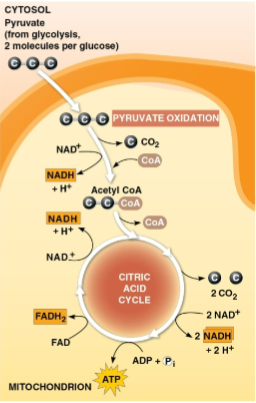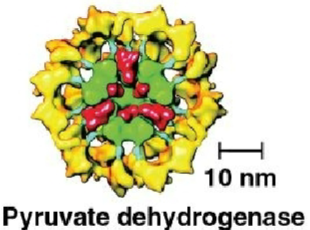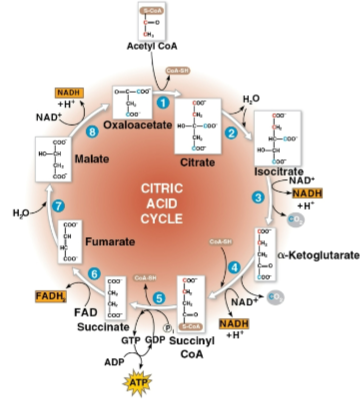Concept 9.3: After pyruvate is oxidized, the citric acid cycle completes the energy-yielding oxidation of organic molecules
1/8
Name | Mastery | Learn | Test | Matching | Spaced |
|---|
No study sessions yet.
9 Terms

Pyruvate
Molecules created as a product of glycolysis in the first step of cellular respiration to be passed into processes for pyruvate oxidation and the citric acid cycle
Pyruvate oxidation
The removal of electrons from a pyruvate molecule before entering the citric acid cycle with most of the energy from glucose remaining
Happens within a mitochondrion if oxygen is present, or within the cytosol for aerobic prokaryotes
Coenzyme A
The coenzyme that pyruvate is joined to to form acetyl CoA after pyruvate oxidation
Acetyl coenzyme A (Acetyl CoA)
The substance pyruvate is converted to before entering the citric acid cycle

Pyruvate dehydrogenase
An enzyme that breaks down pyruvate through the catalyzation of three reactions
Oxidation of pyruvate’s carboxyl group, releasing the first CO2 of cellular respiration
Reducation of NAD+ to NADH
Combination of the remaining two-carbon fragment with coenzyme A to form acetyl CoA

Citric acid cycle (Krebs cycle)
Cycle that oxidizes organic fuel derived from pyruvate, generating 1 ATP, 3 NADH, and 1 FADH2 per turn as well as 2 CO2 as waste
Runs twice per glucose molecule consumed due to 2 pyruvate being present after glycolysis
Has eight steps, each catalyzed by a specific enzyme, to join acetyl CoA and oxaloacetate to form citrate and then decompose it back to oxaloacetate for a cycle
NADH and FADH2 carry electrons to the electron transport chain
Oxaloacetate
The molecule that acetyl CoA is joined with to form citrate and is eventually decomposed back to after the citric acid cycle
Citrate
The molecule that results when joining acetyl CoA and oxaloacetate before decomposing back into oxaloacetate
NADH and FADH2
The two electron carriers produced by the citric acid cycle to carry electrons to the electron transport chain